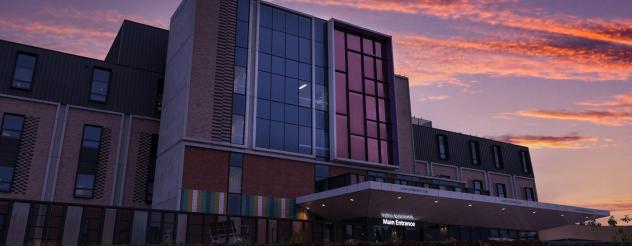How it works
Traditionally, architectural designs would be reviewed and tested by user groups using only 2D drawings, 3D virtual models or physical architectural prototypes.
But Melbourne company Big Plans offers a cost-effective alternative. Using overhead projectors, the architectural plans of our new Wantirna residential aged care facility are cast life-size onto a large white floor. This allows clinicians, nurses, back of house staff, engineers, project managers and designers to walk through full-scale floor plans of the new facility.
Nurses push wheelchairs and move patient beds around resident bedrooms. They’re testing the spatial practicality of doorways and ensuites. Meanwhile, designers are using iPads to view the layout, interiors and sightlines in 3D.
Zoltan Kokai, Executive Director of Information, Technology and Capital Projects at Eastern Health is here with his team to test the plans before signing off on the designs of the new residential aged care facility.
'It is sometimes very challenging to visualise what a two-dimensional plan will look like in 3D,' he says. Today, thanks to this new technique, the team have made a crucial discovery.
'We need to increase the size of the passenger lifts to enable them to carry the king single patient beds we use in our residential aged care facilities, in case one of the bed lifts is temporarily unavailable.'
Zoltan Kokai, Executive Director of Information, Technology and Capital Projects at Eastern Health
'If we had to redesign this later in the process, or retrofit after construction is completed, this would cost a significant amount of money and time.'
Cost-effective design
Our Principal Advisor of Design, Judith Hemsworth explains: 'This technology has enabled the entire project team to fully interrogate the proposed designs and successfully identify a number of enhancements to the care environment for residents. They have also been able to identify any issues that were not immediately obvious from the drawings, which will eliminate potentially costly changes at a later stage.'
'Now we can make the adjustments to the passenger lift size during the design development phase and it won’t have a significant impact on the cost of the project.'
Natalie Pitt, Project architect and director of Silver Thomas Hanley
Helping teams collaborate
But it’s not just about saving money, Hemsworth says.
'I believe the best design outcomes are achieved via a collaborative co-design process between the client, building designers, the project stakeholders and end users as well as our own project planning, design, delivery staff and department and other subject matter experts.' She continues: 'The combination of testing physical objects such as furniture and equipment in a virtual environment, and the ability of the group to interact with, and experience this approach simultaneously, is unique.'
Teams of up to ten people can view and walk through architectural, landscape, interior or mechanical plans at actual size.
This helps people to collaborate, and provides designers and user groups with the opportunity to:
- prototype and refine ideas
- test multiple variations
- optimise designs to eliminate risk early in the design process.
A new aged care facility in Melbourne’s east
The Wantirna residential aged care facility is a new 120-bed residential aged care facility in Wantirna.
The $81.58 million development will provide public sector residential aged care accommodation next to the existing Wantirna Health service. The facility will be dementia-friendly and provide care to older people with complex care needs or limited mobility.
The multi-level facility will feature single rooms with ensuites in a home-like environment. Residents will have privacy and independence while receiving best-practice care for a range of care needs.
The new Wantirna residential aged care facility is due to open mid-2022.
Find out more about the Wantirna Aged Care development via our dedicated project page.
Transcript
Text: A new way of visualising architectural designs was used during planning for the new Wantirna residential aged care facility.
Images: Project team members and various stakeholders are in a large warehouse where the architectural layout plans are projected onto the floor.
Text: Projectors displayed design layouts onto the floor at actual scale.
Images: Project team members are pushing wheelchairs and patient beds through doorways and into lifts. Some team members use iPads to virtually ‘walk around’ spaces as well.
Text: Our project team and stakeholders then ‘walked through’ room layouts, testing dimensions of bedrooms and lines of sight to external courtyards. The project allowed for multiple design tests.
Images: An artist impression of the exterior of the new Wantirna residential aged care facility.
Text: The project is moving towards construction and scheduled to open in 2022
Images: The closing slide is the Victorian Health and Human Services Building Authority logo, the web address vhhsba.vic.gov.au and the Victoria State Government logo.
End of transcript
